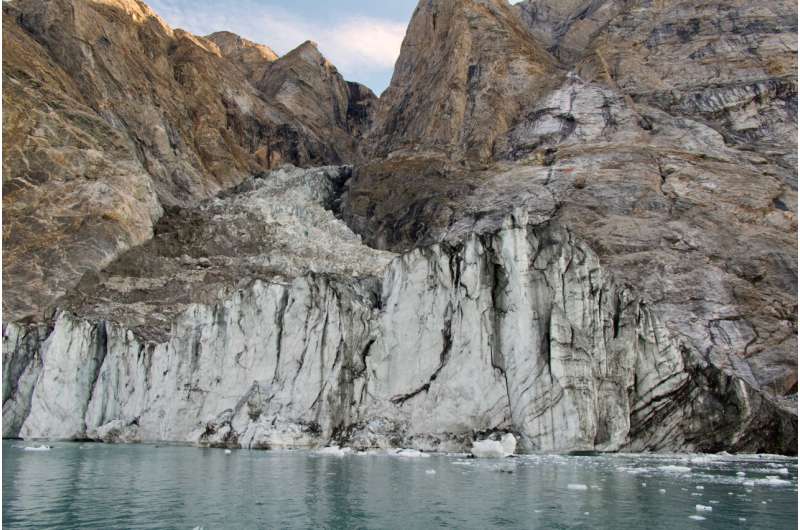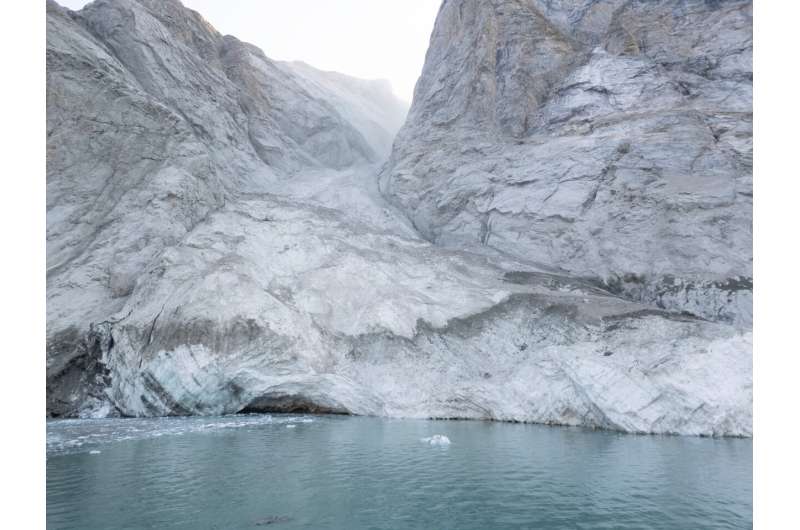
“Before” image of the landslide site taken in August. 12, 2023. Credit: Søren Risgaard
In September 2023, scientists around the world detected a mysterious seismic signal that continued for nine consecutive days. An international team of scientists, including seismologists Alice Gabriel and Carl Ebling of the Scripps Institution of Oceanography in San Diego, came together to solve the mystery.
A study published in science It offers a stunning solution: In one of East Greenland’s fjords, a mountain peak collapsed into the sea, triggering a massive tsunami about 200 meters (650 feet) high. The giant wave rocked back and forth inside the narrow fjord for nine days, creating seismic waves that reverberated through the Earth’s crust, puzzling scientists around the world.
This rhythmic relaxation is a phenomenon known as sichhe. Fortunately, no one was hurt, but the waves destroyed about $200,000 worth of infrastructure at an uninhabited research station on Ella Island.
“When we embarked on this scientific adventure, everyone was amazed and no one had the faintest idea what was causing this signal,” said Christian Essonvig, a geologist at the Geological Survey of Denmark and Greenland (GEUS) and lead author of the study. is
All we knew was that it was somehow related to the landslide. “We managed to solve this puzzle only with interdisciplinary and international efforts.”
Climate change has melted glaciers at the base of the mountain, setting the stage for landslides and destabilizing more than 25 million cubic meters (33 million cubic yards) of rock and ice—enough to fill 10,000 swimming pools. Olympic size is enough – which finally made. fell into the sea As climate change continues to melt the Earth’s polar regions, it could lead to an increase in large and destructive landslides like this one.

Image of the landslide site on September 19, 2023, taken after the September 16, 2023 event. Credit: Danish Army
“Climate change alters what is normal on Earth and can trigger unusual events,” Gabriel says.
When seismic monitoring networks first detected this signal in September 2023, it was puzzling for two main reasons. First, the signal was nothing like the busy contraction that an earthquake causes on seismographs. Instead, it oscillated with an interval of 92 seconds between its peaks, which was too slow for humans. Second, the signal remained strong for consecutive days, where more common seismic events weaken more rapidly.
The global community of earth scientists began to buzz online with an online debate about what could be causing the strange seismic waves. The discussion included reports of a massive landslide in a remote Greenland fjord that occurred on September 16, around the time the seismic signal was first detected.
To discover if and how the two phenomena might be related, the team led by Kristian Essonvig of the Geological Survey of Denmark and Greenland used seismic recordings from around the world, field measurements, satellite images and computer simulations. combined to recreate extraordinary events. .
The team of 68 scientists from 41 research institutions analyzed satellite and ground-based images to document the massive amount of rock and ice in the landslide that caused the tsunami. They also analyzed seismic waves to model the dynamics and trajectory of the rock-ice avalanche as it moved down the glacial gully and into the fjord.
To understand the tsunami and the resulting tsunami, researchers used supercomputers to create high-resolution simulations of the events.
“It was a big challenge to do an accurate computer simulation of such a slow, long-lasting tsunami,” says Gabriel.
Finally, these simulations were able to match the real-world tsunami height as well as the slow fluctuations of long-term seiches.
By integrating these diverse data sources, the researchers determined that the nine-day seismic signal was caused by a massive landslide and the resulting spike in Greenland’s Dixon Fjord.
“It was exciting to work on such a perplexing problem with an interdisciplinary and international team of scientists,” said Robert Anthony, a geophysicist with the USGS Earthquake Hazards Program and co-author of the study.
“Ultimately, it took geophysical observations and numerical modeling by many researchers in many countries to piece the puzzle together and get a complete picture of what happened.”
The findings of this study show the complex and cascading risks caused by climate change in polar regions. While not in the region at the time of the large landslide and tsunami, the fjord is close to a route commonly used by cruise ships, highlighting the need to monitor polar regions as climate change accelerates. For example, a landslide in West Greenland’s Karat Fjord in 2017 triggered a tsunami that flooded the village of Nuugaatsiaq, destroying 11 homes and killing four people.
The results could prompt researchers to look for similar events now that scientists know what they’re looking for, Gabriel said. Finding more seiches could help define more clearly the conditions that lead to this phenomenon.
“It shows that there are things that we still don’t understand and haven’t seen before,” said Ebling, who conducted the study with NSF support and helped manage a network of seismic sensors that detect vibrations at Siche.
The essence of science is trying to answer a question we don’t know the answer to – that’s why it was so exciting to work on.
More information:
Christian Essenwig, a tsunami caused by a rockslide in a Greenland fjord shook the earth for 9 days. science (2024). DOI: 10.1126/science.adm9247. www.science.org/doi/10.1126/science.adm9247
Presented by University of California – San Diego
quote: Climate Change Triggered Landslide Unleashes a 650-foot Mega Tsunami (2024, September 12) on September 12, 2024 from https://phys.org/news/2024-09-climate-triggered-landslide-unleashes -foot.html has been retrieved.
This document is subject to copyright. Except for any fair dealing for the purpose of private study or research, no part may be reproduced without written permission. Content is provided for informational purposes only.
#landslide #triggered #climate #change #created #650foot #megatsunami